by atmara | Jun 8, 2017 | Compassion, Freedom, Inspiration, Meditation, Peace, TED, TED Talks, Video
 According to TED.com: “In our hyperlinked world, we can know anything, anytime. And this mass enlightenment, says Buddhist scholar Bob Thurman, is our first step toward Buddha nature.”
According to TED.com: “In our hyperlinked world, we can know anything, anytime. And this mass enlightenment, says Buddhist scholar Bob Thurman, is our first step toward Buddha nature.”
“The first American to be ordained a Tibetan Monk by the Dalai Lama, Robert A.F. Thurman is a scholar, author and tireless proponent of peace.”
“Tenzin Robert Thurman became a Tibetan monk at age 24. He’s a professor of Indo-Tibetan Buddhist studies at Columbia University, and co-founder of Tibet House US, a nonprofit dedicated to the preservation and promotion of Tibetan civilization.”
“Thurman’s focus is on the balance between inner insight and cultural harmony. In interpreting the teachings of Buddha, he argues that happiness can be reliable and satisfying in an enduring way without depriving others.”
“He has translated many Buddhist Sutras, or teachings, and written many books, recently taking on the topic of Anger for the recent Oxford series on the seven deadly sins. He maintains a podcast on Buddhist topics. And yes, he is Uma’s dad.”
Robert Thurman: We can be Buddhas
For those of you not familiar with TED Talks here is a brief summery from www.ted.com: “TED is a small nonprofit devoted to Ideas Worth Spreading. It started out (in 1984) as a conference bringing together people from three worlds: Technology, Entertainment, Design. Since then its scope has become ever broader. Along with two annual conferences — the TED Conference in Long Beach and Palm Springs each spring, and the TEDGlobal conference in Oxford UK each summer — TED includes the award-winning TEDTalks video site, the Open Translation Project and Open TV Project, the inspiring TED Fellows and TEDx programs, and the annual TED Prize”
——————————————————————————————————–
I look forward to your thoughts and comments!
Like this:
Like Loading...
by atmara | May 8, 2017 | Art, Mandala History, Mandala Monday, Mandalas, Meditation, yoga
The Mandala – Origin and use
The way in which Mandalas are made is already ancient. In the prehistory, the first simple representations were made, which can be compared with the mandala. These include, for example, rock drawings, which according to estimates by archaeologists could be 25,000 to 30,000 years old. These represented circles with a center, which are interpreted by the scientists as sun cycles.
Also in the Celts culture, the Indians, the Aborigines Australia and the South-American Inkas round sample forms with a center were found. In the emergence of different cultures and religions in Asia, the representations of the mandalas were artistically refined and provided with a great variety of colors. The impressive cult designs were filled with religious content and used in various religious rites in the East Asian countries and in India.
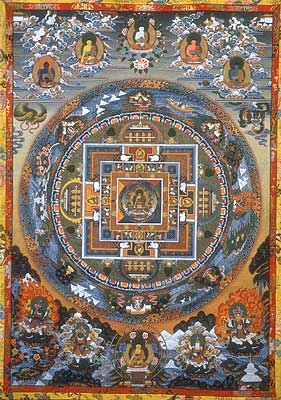
Tibetan Mandala
The versatile use of mandalas
For religions such as Buddhism and Hinduism, which are oriented towards the production of inner and outer harmony as the basis of knowledge and salvation, the mandalas became important objects for meditation. The forms are also found in Christian sacred temples. Medieval church windows and church paintings are often provided with similar representations.
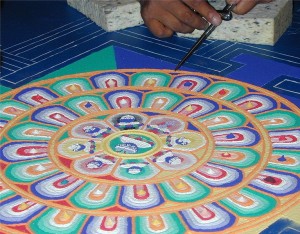
Tibetan monks making a temporary “Sand-Mandala”
in the City-Hall of Kitzbuehel in Austria.
Symbolic representations as a triangle with rays, the Holy Spirit as an illuminated circle, and similar symbols also use the representation principles of the mandala. The centered images greatly enhance the concentration in a meditation.
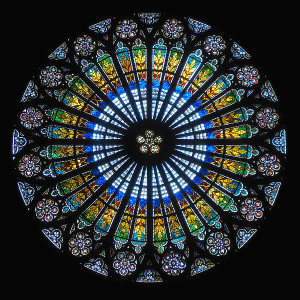
Interior of the rose at Strasbourg Cathedral.
Mandalas in Psychology?
C. G. Jung, a famous psychologist, used the principle of mandalas for examinations and treatments. He noted that a mandala can show the sense of purpose and direction. The Mandalas could convey a sense of structure, security, hope and wholeness in an intense concentration on the picture. In patients, he even found that in certain situations they spontaneously painted mandala forms when asked to paint without prescriptions.
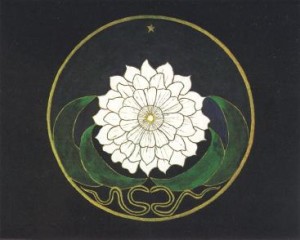
Mandala made by a Jung’s unknown patient before 1929
To date, there are numerous psychologists who use the mandala in their practice. This is based on the realization that the symbolism of a mandala always directly addresses the subconscious. The importance of mandalas, especially the circular shapes and shapes of squares, as an important element in meditation. In deepening into the pictorial representation, in which everything leads to the center, it is particularly well to sink into deep meditation. Especially in Tibet and India, the Mandalas served as meditation symbols and ritual actions.
Mandalas as a help in meditating
In practice, people can use different mandalas in meditation. Regardless of the complicated magical and ritual meanings that the individual mandalas have in different directions of Buddhism and Hinduism, their form is an excellent support. It is helpful to deal with the most important forms and colors at least.
This can accompany the attainment of a deep meditative state of content and lead to the desired emotions. As already mentioned in connection with mandalas in psychology, the subconscious is particularly addressed by each mandala. The view of the mandala, the deepening of its forms and colors, ensures a better concentration. Especially, the view should be directed towards the center.
Nothing around the mandala should distract from meditation. Depending on the condition of the person concerned in the meditation, the mandala can help to feel more peace, harmony, and serenity or to gain new strength, and to release one’s energies for vitality and creativity. However, a mandala never has a detachment from the person. It is always only a means, an important help with intensive meditation and the sinking into one’s own, deeper ego. The actual meditation, the concentration necessary for it always must the man himself. This can not be replaced by the effect of a mandala.
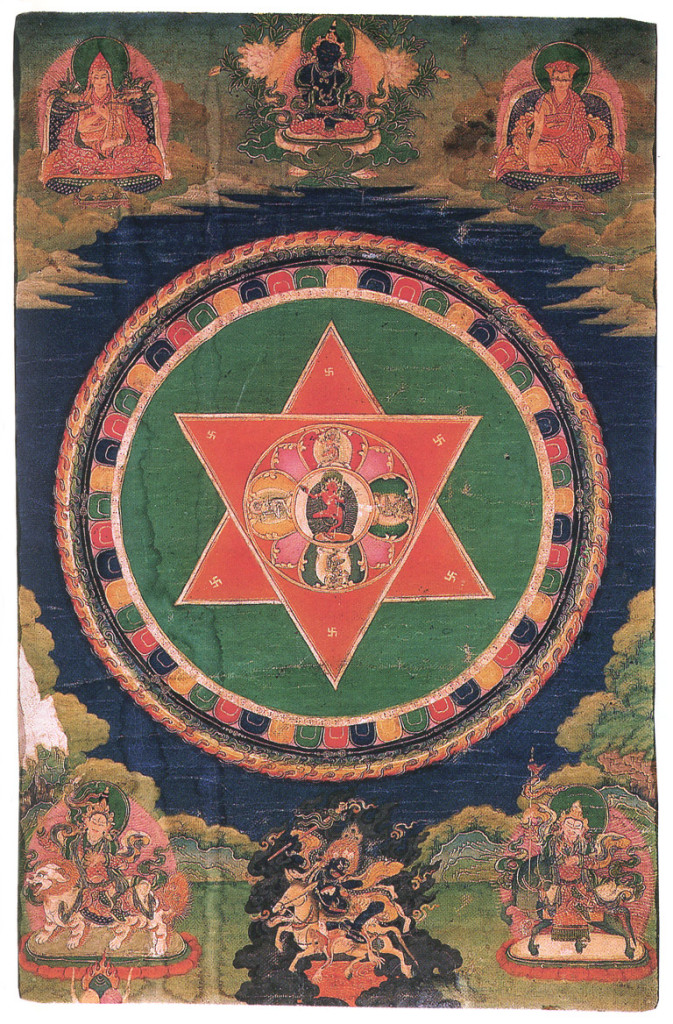 Vajravarahi Mandala
Vajravarahi Mandala
Mandalas, especially in Hinduism and Buddhism, have a ritual meaning as an element of meditation. However, the application goes far beyond the actual roots, so that the psychology and the meditation of the geometric mandala forms positively serve itself. And no, Mandalas do not have to be round. Most of them are actually.
For other offerings of The Yoga Mandala see:
Mandala Beach Blankets
Mandala Tapestry
The Yoga Mandala
——————————————————————————————————–
I look forward to your thoughts and comments!
Like this:
Like Loading...
by atmara | Mar 6, 2017 | Art, Mandala Monday, Meditation, Shree Yantra, Shri Yantra, Yantra, yoga
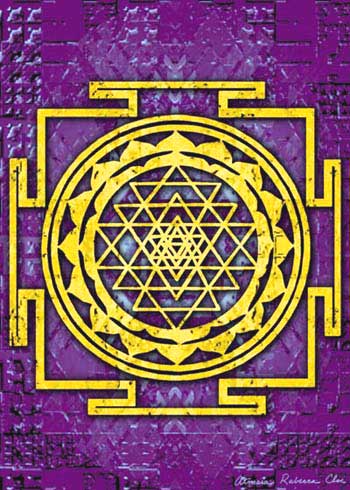 The Sri Yantra is the most powerful of all Yantras, so it is also called the king yantra. It is considered a highly effective tool for meditation, contemplation, and concentration.
The Sri Yantra is the most powerful of all Yantras, so it is also called the king yantra. It is considered a highly effective tool for meditation, contemplation, and concentration.
The Sri Yantra should have a strong influence on success, power, authority as well as a financial success if these aspects are to be achieved within the framework of an honest, careful and peaceful action.
SHREE means Sanskrit prosperity and YANTRA instrument – consequently, it is a graphical instrument for achieving prosperity. The notion of prosperity is, however, not only for the material but also, or primarily, with the nonmaterial, spiritual and spiritual. Meditating on the Sri Yantra helps us on the way to prosperity, harmony and inner peace.
The Sri Yantra is also referred to as the Sri Chakra, as it is considered the primordial Yantra, the mother of all the other yantras that derive from it. The three-dimensional form of the Sri Yantra is to represent Mount Meru, the mystical, cosmic mountain in the center of the universe. Sri Yantra is a representation of creation and is connected with the tree of life. The energetic effect of Sri Yantra should be seventy times larger than that of a pyramid.
The Sri Yantra could be understood as a place of spiritual pilgrimage – it represents the cosmos on the macrocosmic level and the human body on the microcosmic level.
The Sri Yantra is a graphical configuration of nine triangles, composed of two lotus petals, and this in turn from a surrounding gateway, called the “citadel of the earth”. The four upright triangles symbolize Shiva – the male principle the nine interlocking triangles around the Bindu, the central core of the Yantra. In the center are five downward triangles, which represent the Shakti, the female principle. The nine interlocked triangles again form 43 smaller triangles, each with a divine principle with specific aspects.
The aim of the contemplation of Sri Yantra is to discover its innermost sources to promote the process of becoming.
The Sri Yantra is used as part of meditation as a visual aid for the concentration of the mind.
More about The effect of Sri Yantra : https://theyogamandala.com/effect-sri-yantra/
——————————————————————————————————–
I look forward to your thoughts and comments!
Like this:
Like Loading...
 According to TED.com: “In our hyperlinked world, we can know anything, anytime. And this mass enlightenment, says Buddhist scholar Bob Thurman, is our first step toward Buddha nature.”
According to TED.com: “In our hyperlinked world, we can know anything, anytime. And this mass enlightenment, says Buddhist scholar Bob Thurman, is our first step toward Buddha nature.”




 Vajravarahi Mandala
Vajravarahi Mandala